The Most Unwise Battle
 |
| General Paulus is busy overseeing the attack on Stalingrad. |
Everybody knows the basics of the
battle of Stalingrad, so only a brief summary is in order. The Germans went in and didn't come back out. Stalingrad was the turning point of the war in a strategic sense, so it is worth exploring.
 |
| June 1, 1942, at the HQ of Army Group South in Vinnytsia, Ukraine. Hitler poring over the map, with Paulus standing attentively behind him. Contrast this with the well-known picture of Hitler and Manstein planning the defense of Zaporizhzhia in February 1943, below. |
 |
| This is the Manstein shot. Note that this is after Stalingrad, and Hitler's confidence has been shaken. Hitler never would have allowed Manstein to appear like this, so dominant, at any other time. Manstein's posture screams, "I've got this!" Now, comparing the photo above of Paulus and this one of Manstein, and based just on the two pictures - whose campaign do you suppose turned out better? A tale of two Generals and two campaigns. |
After his initial drive of 1941 failed to conquer the Soviet Union, Hitler built up his forces in Army Group South during the following spring. After soundly beating the Russians in their own ill-advised offensive in May 1942 (where his repetitive strategy of steadfastly holding the 'corner posts' and turning a bulge in his own lines into a pocket actually worked for a change), Hitler sent his own troops in motion.
 |
| After those last pictures of Paulus, Manstein, and Hitler, let's get real. To say that the Germans were image-conscious is to vastly understate how much value they placed on propaganda poses. Usually, when portraying the 'generalship' side of things, they took pictures of impeccably clad Generals standing stolidly over the map table, ostensibly planning their next masterstroke of tactical genius. The reality, though, is that much of the real planning took place in situations like this shot from the summer of 1942: a bunch of shirtless and shoeless guys in a dugout figuring out how many men they had left to capture the next vermin-infested village. This was how they got to Stalingrad. |
Under Field Marshal von Bock (who replaced General Walther von Reichenau, who had died of a stroke in January), the vastly reinforced Army Group South (which received the vast majority of all reinforcement sent from Germany to Russia that spring) set off to seize as much territory as possible.
 |
| Paulus is shown conferring with his aides while times were still good. To his credit, Paulus at least is not 300 miles behind the lines staying in a luxury hotel like some of the German generals. |
Bock was a strange choice, having been defeated before Moscow the previous winter and removed from command. At the beginning of Blau, he made a few moves that Hitler did not like, but they were extremely minor details in an overwhelmingly successful campaign. In fact, it was fairly amazing that the Germans even got across the Don, much less reached the Volga. Many years after the war, Charles de Gaulle commented on this as being an extraordinary achievement.
 |
| Stalingrad 11 days before the first bombing, with German troops still dozens of miles away. One can see that the workers' settlements at the lower-left could be destroyed with fire-bombing, but not the built-up areas along the river. The former was captured easily, the latter - never completely. |
Hitler, however, was extremely nervous about wasting any time whatsoever, and still nursed a grudge against von Bock from the previous May (the defense of Kharkiv, which Hitler thought von Bock mishandled despite it being a massive German victory). Hitler peremptorily dismissed von Bock in mid-July due to some minor issues involving troop movements around Voronezh, which von Bock protested had been done with complete transparency "as plain as the sun."
It is unclear why Hitler was so upset with von Bock, but one can read into the overall situation an issue that ran all the way back to the planning stages of the campaign. Many of the generals, perhaps the overwhelming majority of them, felt that Moscow was a better target than the oil fields. Hitler overruled them, but he knew that sentiment lingered. Bock's placement of the weight of the armored forces at Voronezh, at the extreme northern end of the battleground and midway between Stalingrad and Moscow, may have suggested to Hitler that von Bock was still thinking of using them to strike north, behind the Soviet capital.
In fact, it is arguable that moving north along the Volga instead of to the south toward Stalingrad would have been the wiser strategic decision. Given sufficiently favorable battlefield victories, this would have decapitated the Soviet leadership and perhaps have ended the war in 1942. Driving south stood no chance of that, though that was where the oil was that Hitler knew the German economy desperately needed.
So, the firing of von Bock was actually of greater moment than historians usually give it. Hitler once and for all staked the fate of the Third Reich on seizing the oil fields to prop up the German economy for a long war rather than go for the quick win by taking Moscow.
 |
| June 1942: Abandoned T-34 Soviet tanks by the railroad tracks. Scenes like this gave the German commanders the false impression that Soviet resistance would collapse. |
Von Bock remained retired until shot in his staff car on the last day of the war. Coincidentally, that same date when von Bock turned over command - 17 July - is the one the Soviets defined as the start of the Stalingrad campaign.
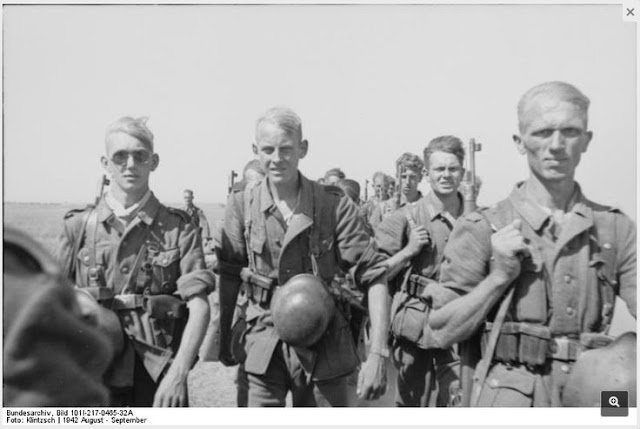 |
| Sixth Army men are seen marching the dusty road to Stalingrad (Klintzsch, Federal Archive). |
At first, Hitler's decision appeared to pay off. Paulus, effectively in control of operations because he slavishly followed Hitler's directives, quickly turned the armored forces south. This involved a long drive that strained German resources such as fuel and exerted a great deal of wear and tear on the equipment, but the Soviets offered little resistance as the Wehrmacht changed the weight of the offensive to the south.
General Maximilian von Weichs, a very competent officer who had been leading the 2nd Army on the north flank of the Army Group South advance toward Voronezh, took over the Army Group from von Bock. At the same time, the army group was split into two parts, A and B, with Weichs in command of Army Group B which had Stalingrad as its objective; Armeegruppe A in the Caucasus Kleist was extremely competent, but his forces were under-strength for the massive objectives before him. Kleist's influence on the Stalingrad battle was negative because Hitler continually placed too much emphasis on operations in that sector.
 |
| Oh yay! Only 13 more kilometers to Stalingrad! This gives a good indication of the territory over which the Soviet troops advanced some months later to surround the city - though then it was covered with snow. (Sautter, Federal Archive). |
The tacit but obvious 'first' goal of the German summer offensive was to seize the Soviet oil fields in the Caucasus - which goal, in fact, was achieved on schedule (but the retreating Soviets ruined the fields, left behind fake "oil field plans" and the wells never produced a drop of oil for the Germans). One of the enduring myths of the campaign is that the Germans never got the oil. In fact, they did seize the main oil fields - they just could not exploit the fields in the roughly six months that they held them.
 |
| Panzer grenadiers advancing on Stalingrad in SdKfz 251 half-tracks. The roads, of course, are mud, and the way is clear from the burning villages on the horizon. |
The tacit German goal never put on paper but obvious from the map, was to continue heading south toward the friendly Iraqis and Turks (probably not bothering to stop at the border, but we'll never know). This also would have closed one of the main Allied supply lines to the Red Army that was being developed through Iran.
 |
| Stalingrad during heavy fighting a couple of days before the Germans reached the river in the south, thereby cutting off the Soviets in the heart of the city. There already are signs of heavy bombing damage, and Luftwaffe General Wolfram von Richtofen could now send his planes in lower to take better snapshots (Ang, Federal Archive). |
German mobile forces then - if all went well - would continue down and eventually hook up with General Rommel's troops advancing east from North Africa. This would ruin the British presence in the Middle East and provide Germany with enough oil in perpetuity to fuel its military machine. To accomplish this, a 'block' was needed at Stalingrad to hold off Soviet forces concentrated in the north for the defense of Moscow).
 |
| This is what awaits: German 81mm mortar crew beside knocked out T-34, September 17, 1942. |
Yes, that plan sounds grandiose, and it was. However, from a grand strategic perspective, it made perfect sense - so long as the Soviets could not intervene south and west of Stalingrad. Since the Red Army was in disarray, the German tactical problem was seen more as occupying vast stretches of empty territory and preventing Soviet counterstrokes from the Moscow region than as overcoming a deadly and committed enemy.
 |
| Nikita Khrushchev comforting a woman in Stalingrad right before the Germans arrived. Khrushchev was a political commissar at a time when they played a major role in military leadership, though that status had been recently downgraded at the time of Stalingrad. Khrushchev remained in Stalingrad throughout the battle. He became the Russian Premier in the 1950s after Stalin's death, with his main claim to fame his involvement at Stalingrad. However, the extent of his impact on the battle is debatable; in his memoirs, General Chuikov, who actually sat in a bunker in Stalingrad directing operations, barely mentions him. |
Stalingrad was planned to serve as little more than the defensive anchor to hold back the Soviets on the north flank; there never was any plan to advance further east from Stalingrad except in a south-easterly direction down the Volga toward Astrakhan. Stalingrad itself was of little use, though from there the Germans could (and did for a while) stop Soviet river traffic on the vital Volga River. It was just a small factory town whose only real value was its location.
 |
| Marching into Stalingrad. They go in... but they don't come back out. |
Splitting his forces with the two new Army Groups - which were Army Groups in name only because of the inclusion of unreliable armies from Italy, Hungary, and Romania - Hitler was confident and at first sent only the large Sixth Army under General Paulus toward the most important objective, Stalingrad.
 |
| Hungarian officers near Stalingrad 1942. |
Hitler sent General Hermann Hoth's Fourth Panzer Army due south to help with the Caucusus campaign. A couple of weeks later, though, he became nervous and turned Hoth northeast toward Stalingrad again. The allied armies were called upon as well to guard the flanks of the advance.
 |
| "Hi, boys!" Ivan carefully set up this skeleton for the advancing Wehrmacht troops nearing Stalingrad as a kind of practical joke. The German soldiers indeed appear amused. Quite amused. |
All Paulus with his Sixth Army was supposed to do was take the city of Stalingrad and then sit tight. In fact, according to the original Hitler directive, he didn't even have to take the city - just bring it under artillery fire. The Don line to the northwest was more important to Hitler than the Volga one since there were no plans at any time to actually cross the Volga into Asia.
 |
| This picture gets a lot of play, but nobody seems to know who it is. It is an officer candidate in a Panzergrenadier unit before the Battle of Stalingrad. He has the Iron Cross (1st and 2nd Class), Infantry Assault Badge in Silver, Armor Assault badge in Bronze, another ribbon, and a Wound Badge in Black or Silver. (Information found in "Panzergrenadiers in Action," from Squadron/Signal Publications, page 30). Obviously, he is a warrior. |
The late diversion of Hoth's tanks to assist Paulus by coming up from the southwest while Paulus drove in from the northeast was considered sufficient to seal the deal. From all appearances, Soviet resistance was collapsing and the occupation of the city fairly routine.
 |
| German sniper in Stalingrad, September 1942. Stalingrad was, of course, a death trap for everyone, Soviet or German alike, and snipers were killed just like everyone else. However, because of the rubble that provided endless concealment possibilities and the close quarters of the fighting, Stalingrad was fertile ground for snipers - much like, say, Fallujah in Iraq would become for American snipers 60 years later. |
The two armies, though, weren't enough. The Soviets were purposefully retreating - how purposefully is still a matter of some debate - and keeping their forces largely intact. Basically, the Germans had to keep chasing the Soviets further and further to the east. This was possible, but every mile further east strained German supplies that much more and required the Germans to defend more ground on their flanks against an as-yet undefeated enemy.
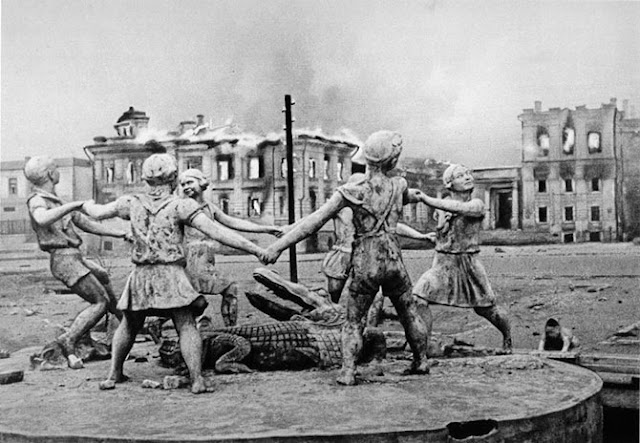 |
| A fountain called "Children's Dance" on the station square of Stalingrad after the August 23, 1942 raid. The station itself is ablaze. |
Luftwaffe General Wolfram Freiherr von Richthofen sent his bombers in on 23 August 1942 to soften up the city. Stalingrad was still at that point operating under relatively normal conditions, more or less. The street cars were running and people were going about their normal routines. All that changed on 23 August.
It wasn't normal afterward.
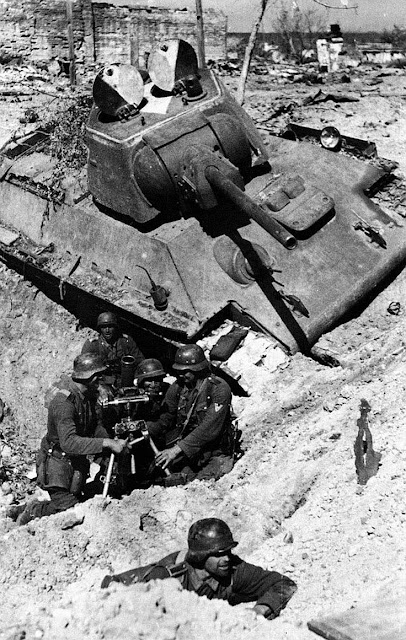 |
| The same picture as above in black and white - September 17, 1942 - a turning point that nobody recognized at the time. Sometimes, black-and-white photos are best to give the real flavor. |
German tanks under General von Wietersheim powered through to the Volga at the end of August, but the spearhead was thin and they then had to form a hedgehog defensive position until Paulus could catch up. They had to beat off intense counterattacks, but also managed to interdict shipping on the Volga for the first time.
 |
| Snipers ruled at Stalingrad. Here, Vasily Zaytsev brandishes his rifle with Mosin-Nagant scope. Zaytsev set up a sniper school on the battlefield, producing many excellent snipers who are estimated to have killed up to 3000 Germans. Zaytsev was famous for attaching the scope to a 20mm antitank gun and using it to blast Germans hiding behind walls. |
Sixth Army was delayed more by lack of fuel than by the Soviets, though the Soviets did mount several fairly ineffective counterattacks from the north. Paulus got through to save the panzers just in time, but the incident was an early indication of just how stretched the Wehrmacht advance was becoming.
 |
| Soviet soldiers at the Red October factory in Stalingrad 1942. The Soviet photographers loved to show the soldiers in heroic poses, but the shots are still invaluable for showing the environment and attire of the men. |
By early September, Paulus and Hoth had a continuous line that touched the Volga in several places to the north and south, but they still had virtually the entire city left to occupy. Technically, this was not required, as the only real value to Stalingrad was closing the Volga and establishing a secure defensive line in the vicinity; this could be accomplished without actually occupying Stalingrad and was accomplished by mid-September.
 |
| Soviet propaganda shot at Stalingrad. He looks a lot warmer than most of the Germans. Notice, however, that the clothing is not white. This is odd because the Soviets had learned hard lessons during the Winter War about proper winter clothing, which should be white. Perhaps he is wearing the olive-green overalls for contrast against the background for the photographer. |
However, as time went on, Hitler completely lost his perspective and insisted on the total capture of the largely worthless third-tier city. Troops were fed in continuously, but still, their offensive capability dropped. It was a modern version of the Verdun meatgrinder.
 |
| Soviet sniper Maxim Passar in Stalingrad, 1942. He no doubt is amused to be holding an assault gun that he may have captured from one of his victims; his standard tool of trade would have been a rifle with Mosin-Nagan scope. Asian Soviet soldiers became more noticeable as the war rolled eastward. Stalingrad, after all, lies on the doorstep to Asia. |
Snipers became extremely useful during the battle because of the restricted fighting space. Both sides used them, and they brought in some of their best talents. Snipers would hide for hours and hours in a blind to finally get a shot. They used all the tricks of the trade, and many lost their lives. Naturally, they focused on higher-priority targets such as officers.
So, Wehrmacht officers became in short supply at Stalingrad - they made good sniper targets with their distinctive Hugo Boss uniforms. Paulus sent surplus Luftwaffe troops to Officer Candidate School to solve this problem. However, the Luftwaffe troops, mainly taken from airfields far behind the lines, were not too thrilled about this. When they objected and demanded to be returned to their original postings, Paulus removed them from the training program, gave them rifles, and sent them to the front line. There was no time for shirkers in Wehrmacht, a battle had to be won.
 |
| Soviet sniper Viktor Medvedev became another hero of the Stalingrad battle. Unlike Passar, he's holding his standard sniper rifle equipped with the scope. The photographer may have been having some subtle fun with these shots, but they work. |
Tanks were of little utility in the confined space, and every ruined building became a fortress for the defenders. Still, the Germans advanced steadily, and in fact, were advancing right up until the day of the Soviet counterstroke.
 |
| This obviously is a nicely framed, poetic propaganda shot. However, let us take a moment to honor the civilians of Stalingrad who suffered without the opportunity to fight back. |
By the end of September, the Axis forces had confined the Soviets to narrow slices along the river, where defending Soviet General Chuikov and his troops, as he put it, 'sat with our feet dangling in the Volga.' Supplies for the trapped Soviet forces were possible only at night across the broad river.
 |
| Infantry trying to keep warm, perhaps lighting a fire. That appears to be a StuG (assault gun) behind them. No quarters for these guys, they rested on the open steppe and their vehicle was their barracks. You can tell from the snow on his parka that the soldier in the foreground had just gotten up - imagine 'resting' outside in sub-zero weather with no shelter for weeks on end. |
Despite everything, the Germans remained on the offensive through October and November while suffering vicious troop attrition due to the house-to-house battles. Soviet General Aleksandr Rodimtsev in command of 13th Guards Rifle Division (this was an honorary designation conferred in January 1942) led his troops across the Volga at night just in time to hold a key sector of the front and thereby became a propaganda hero (which also earned him some resentment from others who also were fighting with extreme bravery).
 |
| Krylov, Vasily Chuikov, Kuz'ma Akimovich Gurov, and Rodimtsev. Rodimtsev brought his division across the river at a key moment and received much glory as a result. Chuikov, the real savior of the city, somewhat resented the adulations Rodimtsev received in the press but at least received some of the credit for the final victory at Berlin in 1945. |
Rodimtsev already was a Soviet propaganda staple. He had become a Hero of the Soviet Union during the Spanish Civil War in the 1930s, something that many Soviet soldiers gladly risked their lives to achieve due to the glory and lifetime benefits, Rodimtsev earned an extraordinarily rare second such award due to his efforts at Stalingrad. Somewhat oddly for a man who was among the most decorated Soviet soldiers of the war, he did not ascend to the highest ranks of the military during his long post-war service. It may have had something to do with resentment from others, or perhaps he just was not political enough.
 |
| General Rodimtsev during the battle of Stalingrad, 1942. |
The Germans, despite rising casualties, kept pressing into the city. In fact, on the very day of the Soviet counter-offensive 'Uranus' against the defending flank troops along the rivers north and south, 19 November, the Sixth Army forces within the city were on the offensive and occupied a few more Stalingrad buildings close to the river. Offensive operations in Stalingrad only stopped that night, close to midnight on 19 November, pursuant to a teletype order from Weichs (who was safely behind the Don).
 |
| Both sides used horses for their supplies at Stalingrad. This picture shows horse-drawn wagons accompanying camouflaged Soviet tanks during Operation Uranus near Stalingrad. |
The Red Army Army did not direct Operation Uranus at Stalingrad itself. Instead, it aimed for the weak link in the German position behind the front. This was located about 40 miles (64 km) to the west. The critical point was a rather ordinary bridge across the Don River at Kalach.
The reason why this nondescript bridge was so important was that the rail line that had been converted to the German railway line gauge from the West that ran Gorlovka-Likhovskoy-Morozovsk-Tchir-Gumrak stopped at the Don. There, supplies had to be loaded onto horse-drawn carts, taken across the bridge, and then reloaded onto Russian trains that could run on the slightly wider Russian railway line gauge for the final run into Stalingrad.
It was across this single bridge that all of the supplies for the German Sixth Army and Romanian 3rd Army had to cross. Without those supplies, those armies were helpless, because adequate air resupply to the two airfields in Stalingrad was impossible for a variety of reasons.
This critical bridge was taken in a lightning assault on 23 November. Regardless of what happened elsewhere on the perimeter, once the bridge at Kalach fell, time was beginning to run out for the 300,000 men trapped in Stalingrad.
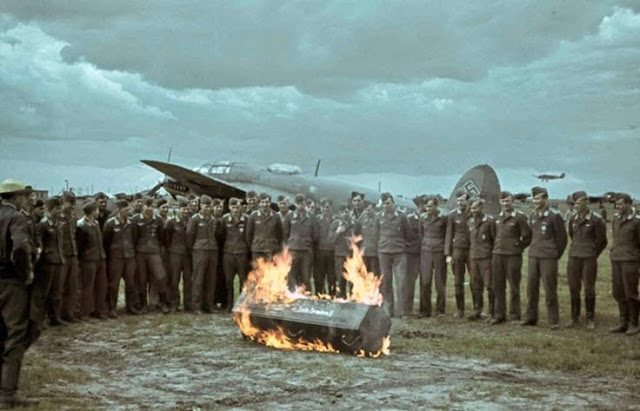 |
| This is one of the more unusual shots I have seen from World War II. It is a group of German pilots of Heinkel He-111 bombers - pressed into service for the emergency airlift - at some sort of symbolic wake. I don't believe anyone specific has died - rather, they are attending their own mock funerals. The coffin is inscribed in German: “Dein Leben – dein gewinn” – or, "your life – your reward." Also, “mich auch” – "for me, too." This is an awesome shot on so many levels - the pilots showing their morbid understanding of their own likely fates, the bomber in the background, the one flying on the horizon. Hundreds of planes were lost during the airlift. This was taken by Siegfried Lauterwasser at Tatsinskaya airfield, the main supply base 260 km from Stalingrad, fall of 1942. The airfield was lost by the end of the year and in fact the failure to hold it sealed the fate of the Germans in Stalingrad. This is an original color photograph. |
So, once the bridge at Kalach fell, the only Sixth Army link still had to the outside world was via the two main airfields within the pocket. These were at Gumrak and Pitomnik. A later Soviet offensive against the Italian 8th Army, holding a stretch of the Don River line north of the city, later broadened the Soviet offensive. This led to the loss of the closest airports outside the pocket supplying the trapped 6th Army in Stalingrad. After that, supply and evacuation flights became extremely hazardous, ultimately having to cover 200 miles of enemy territory which were full of anti-aircraft fire and Red Air Force fighters.
 |
| A dog sits in the snow watching a column of Axis Italian soldiers of the 8th Italian Army, also known as the Italian Army in Russia (Italian: Armata Italiana in Russia, or ARMIR), retreating during the Battle of Stalingrad. Stalingrad (Volgograd), Volgograd Oblast, Russia, Soviet Union. December 1942. |
General Hoth, who remained outside the city with the part of the Fourth Panzer Army that had not been sent to Stalingrad, launched the relief attempt Operation Winter Storm on December 12, 1942. After getting about halfway to the city, though, it failed by Christmas and was sent reeling westward. There was an entire German Army Group just to the south that could have supplied more troops for the relief, but Hitler refused to authorize any transfers, fearing loss of territory there as well.
 |
| Soviet troops advance through a trench at Stalingrad. |
Valiant air supply efforts also failed, though many were flown out of the doomed city. A Soviet offensive beginning on 10 January 1943 eliminated the western half of the pocket. The last Luftwaffe plane out of the pocket was either on the afternoon of 22 January or the morning of the next day - reliable records are sketchy. The Germans lost their second and last airfield on the afternoon of 23 January 1943, leaving them completely isolated. Paulus and his corps commander General der Infanterie (Lt. General) Karl Strecker (11th Corps) individually surrendered January 31-February 2 1943, and very few Wehrmacht POWs aside from Paulus lived to see Germany again.
 |
| Gen. Vasily Chuikov, defender of Stalingrad, circa the early 1940s. Chuikov never really got the credit that he deserved from post-war histories for standing with his 'feet dangling in the Volga,' as he later put it, during the dark days of October 1942. There were other Generals in the vicinity, such as Colonel-General Aleksandr Rodimtsev, who were given more propaganda publicity, but absolutely nobody was more integral to the success of the Soviet victory at Stalingrad than Chuikov. He was a tough, no-nonsense General who had to change his command post several times under fire. Chuikov was in on the capture of Berlin in 1945 as commander of 8th Guards Army, accepting the city's surrender from General Weidling (General Krebs having committed suicide). Chuikov had a brilliant post-war career, culminating in his appointment as Marshal of the Soviet Union and command of Soviet ground forces. He helped to design the Stalingrad memorial at Mamayev Kurgan and is buried there. |
Strecker held out for a couple of days after Paulus, but it was completely hopeless and his men essentially were in an armed prison camp during that time, with nowhere to go and nothing to do. His last message, and the last German message from Stalingrad, was:
XI Corps, with its six divisions, has done its duty to the last. Long live the Fuhrer! Long live Germany! - Strecker.
Strecker himself did survive captivity. Senior officers received better treatment than the ranks, at least during the war, though at least one general officer, Field Marshal Paul Ludwig Ewald von Kleist, who was captured at the end of the war did die from mistreatment. Strecker died in Austria in 1973 after being held captive - like the other Stalingrad prisoners - until 1955. Paulus survived captivity also, though his movements were never completely free, and died in Dresden, East Germany in 1957.
Hitler knew that Stalingrad was a major turning point in the war. However, he instructed the propaganda ministry to use the loss as a call to arms for the German people. The old characterization of the situation as "total war," used during World War I, was revived.
 |
| Hitler addresses thousands of Party members and ‘fellow soldiers’ at the Berlin Sports Palace on 30th January 1943, the day he gave a speech every year in commemoration of taking power. This was a special event since it was the tenth anniversary. After approaching the lectern “such was the roaring hurricane of jubilation” that he was unable to speak for several minutes -- despite the backdrop of the devastating defeat of the German army in Stalingrad. Paulus surrendered the next morning. The strain on Hitler is evident in his bearing, and in photos like this one, we start to see his left arm bent in that familiar way that later would be diagnosed (posthumously) as a probable symptom of Parkinson's. |
 |
| Advancing on the outskirts, mostly small worker settlements. |
 |
| Aerial bombardment was fierce. Soviet artillery on the far shore played a decisive role and caused much of the devastation. This shows the infamous tractor factory, which produced T-34 tanks during the early stages of the battle. Women of the 1077th Anti-Aircraft Regiment engaged the 16th Panzer Division here over open sights with 37 artillery pieces and no infantry support. After they all were killed, other Soviet soldiers arrived. The Germans finally took the tractor factory on 16 October after brutal savagery. |
 |
| Aerial view, 1942 (Niemann, Federal Archive). |
Regardless of wins and losses, the city was absolutely devastated after six months of close-quarter fighting.
 |
| Camels were common at Stalingrad as pack animals, even during the brutal winter. |
 |
| Children of Stalingrad in a bunker. Vicious air attacks commenced on August 23, 1942. |
 |
| This is a reality of war - people stop caring. This woman strolls calmly through the battlefield as troops fire right beside her. She finally just packed up a few items and left; perhaps her home was in one of those burning buildings. She has the clothes on her back, a couple of bags, and something that looks like a coffee pot. She's like, "Do your worst, I don't care anymore, I'm leaving." I bet out of everyone, she survived everything, too. |
 |
| The city burning, civilians scrambling. |
 |
| A German mortar squad. Note the mortar baseplate. |
 |
| Probably October 1942, note the gloves. |
 |
| General Friederich Paulus (Commander 6th Army) decorates General Alexander Von Hartmann (Commander 71st Infantry Division) with the Rittrerkreuz (Knight's Cross of the Iron Cross) on 8 October 1942. Hartmann suffered a hero's death fighting with remnants of his Division at the front on 26 January 1943. Paulus, of course, surrendered a few days later. |
 |
| A German machine gun squad. |
German photographers had an easy job finding heroic-looking Wehrmacht soldiers for their propaganda - it was easy to look heroic surrounded by devastation and destruction. Some of these photos are from the German Federal Archives.
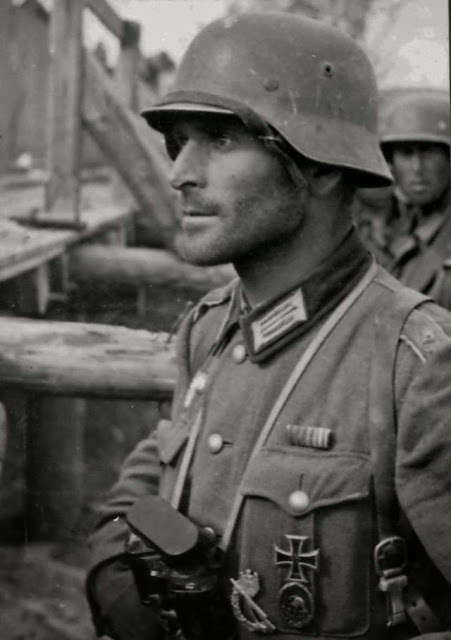 |
| Even the propaganda soldiers got kind of scruffy with no hot water to shave. This is Hauptmann Friedrich Konrad Winkler, Stalingrad, 1942. Note the broken Infantry Assault Badge - Stalingrad vets did this to signify how different that achievement was in the inferno of Stalingrad than elsewhere. Hauptmann Winkler was one of the 91,000 odd German soldiers who surrendered in 1943. Winkler died between February 8 and 10, 1943 at POW Camp Beketowka. |
 |
| German officers conferring in front of a still-working half-track, October/November 1942. |
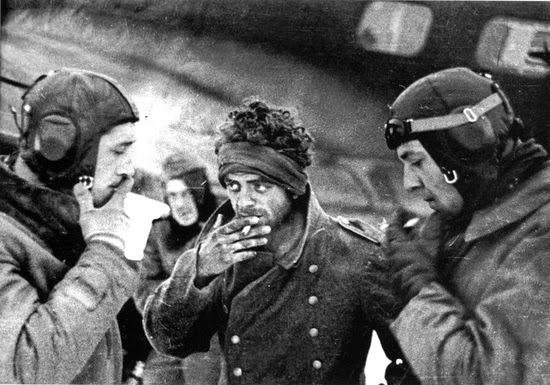 |
| A wounded German, being evacuated from Stalingrad, shares a smoke with the evacuation plane pilots. About 31,000 wounded men made it out that way - it was the only way out after 23 November. Passes for the planes out were exceedingly difficult to get, and even if you had them you might not make it on board. |
 |
| One of Paulus' last messages referenced the Swastika flag flying over the central square in Stalingrad and that he and his men intended to fight it out to the end "under this symbol." |
 |
| This photo gets a lot of attention these days. (Gerrymann, Federal Archive). |
 |
| A Romanian ally of Germany, guarding the flanks. After they fled in November, the ground was littered with their distinctive helmets, marking their spot (Ang, Federal Archive). |
 |
| Soviet propaganda photo from Operation Uranus. |
 |
Soviets attack on 19 November 1942. The Germans were surrounded by 23 November 1942.
|
 |
| Soviets on the attack, 19 November 1942. |
 |
| Germans manning an antitank gun in front of what appears to be the Communist party headquarters. |
 |
| German tank Pz.Kpfw. IV Ausf. G (Sd.Kfz. 161/2) during Operation Wintergewitter, the weak rescue attempt. This is near the village of Kotelnikovo. The machine has “Eastern” tracks (Ostketten), December 1942. |
 |
| Hoth and his tanks were the last hope for the 6th Army on 12 December, but they fell short. It was impossible to hide from the men fighting in surrounded in Stalingrad because they could hear the guns stop getting closer, and then receding. Fourth Panzer Army was on the run back to the starting point by Christmas, and from there the retreat continued. |
 |
| Soviet soldiers celebrating victory on 2 February 1943, when the last corps under Strecker surrendered. Note the bombed-out buildings, the rubble under their very feet, the craters... yes, boys, lots to celebrate. One of the most unintentionally telling photos of the war. |
 |
| I am told this was taken after the surrender, but they probably didn't look all that much better before, either. |
 |
| German POWs shuffling through the ruins. The percentages state that out of all the prisoners to be seen in this photograph, one and one only would live to see Germany again sometime in the 1950s. |
 |
| The Soviet guards offered some human kindnesses at times to the captured Germans, but in any event, they had little enough themselves. |
 |
| Captured at Stalingrad, from left to right: Generalleutnant Arthur Schmidt, Oberst Wilhelm Adam, and Generalfeldmarschall Friedrich Paulus. Paulus became a turncoat soon after the surrender, but not Schmidt, whose fault was that he did not realize the gravity of the situation soon enough. |
 |
| Captured saddles and other German equipment. |
 |
| Stalingrad. |
 |
| Weapons collection afterward. |
Below: the beauty of peace: Returned residents of Stalingrad take a stroll through a park where Luftwaffe planes, abandoned by the Germans, are lined up as relics of the battle. From left to right: reconnaissance Focke-Wulf Fw 189A, dive bomber Junkers Ju 87B / R "Stuka," fighter Messerschmitt BF.109F / G. The photo was taken in spring 1944, and green has returned to the battlefield.
 |
| Abandoned German aircraft in 1944. That appears to be an FW-189 on the left, a Stuka Ju 87 in the background. They'd be worth quite a lot of money now. |
In the picture below, taken five years after the end of the battle, Stalingrad is still in ruins. Transport is still scarce and the old man here has engaged a Bactrian camel to pull his cart. The big ruined building in the background is Stalingrad's No. 1 train station. Life goes on.
 |
| Five years later, the city still in ruins. |
 |
| The land of sunflowers and battle debris: Soviet T-26 Tank abandoned during the retreat of Soviet troops on the western outskirts of Stalingrad in 1942. |
 |
| The city (Volgograd) recently. |
Here are some more photos of Stalingrad which amplify what is above:
 |
| Fighting in the Red October factory |
 |
| Another shot of the Red October factory, this time showing some Soviet soldiers at the gate. |
 |
| Soldiers attacking. Who knows which side. |
 |
| Soviets on the attack. |
 |
| The victory flag is raised over the central plaza, heralding an end to the battle. This scene may look vaguely familiar to Call of Duty fans. |
 |
| Local children, colorized. |
 |
| Soviet troops enter the burning city. |
 |
| Soviets pass an abandoned German 37 mm gun PaK 35/36. This appears to be the central square with the Communist party headquarters. |
 |
| German POWs. |
 |
| Prisoner column near Stalingrad (Ang, Federal Archive). |
 |
| Assuming 50 men being led to prison here, only about three - perhaps those three in the front row - ever made it home to Germany. The rest died of starvation, overwork, mistreatment, "trying to escape," torture... you know the drill. |
 |
| German graves right after the battle. The Germans liked to put up wooden crosses as memorials to honor their dead, but the locals just used them as firewood. |
2022





























































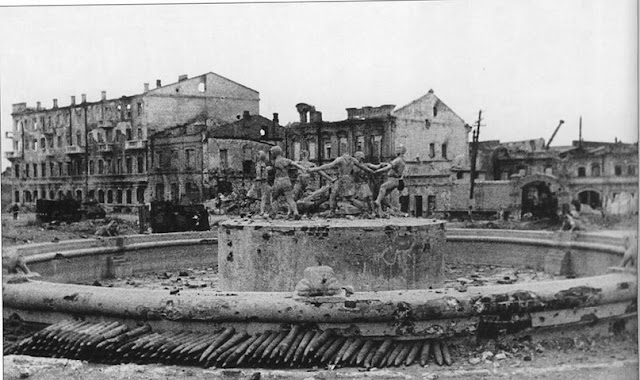














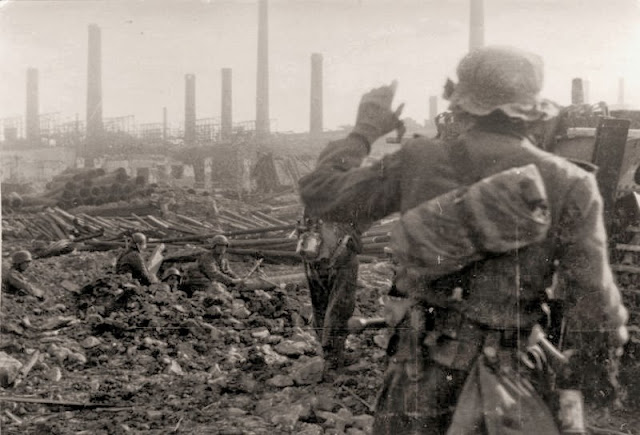















Dear Mr. Bjorkman, The name of the German 11th Army Corps Commander is General Karl Strecker, not Streicher.
ReplyDeleteThank you, Raja. You are 100% correct. That was a silly error on my part, and I have corrected it. I was thinking phonetically I suppose, just an example of how the mind can play tricks on you. Appreciate your reading so closely and catching my error.
Delete'Abandoned German aircraft in 1944. That appears to be a He-111 on the left, a Stuka Ju 87 in the background'.
ReplyDeletePlane on the left is a FW189 and not a He111. The FW189 is easy recognizable by the distinctive Argus adjustable propeller and hub.
Thanks for the ID, siebel204, I was just shooting from the hip on that one and was hoping someone would recognize it.
Delete